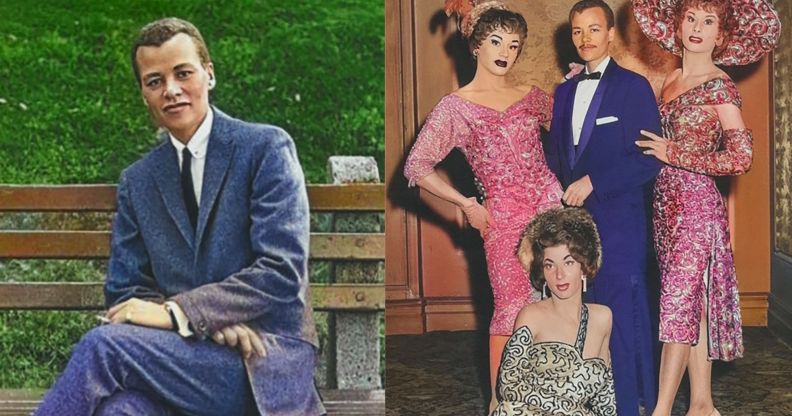Trans people have always been here – and these incredible colourised photos prove it

Trans activist Eli Erlick has been colourising photos of trans people throughout history to “remind viewers that trans people – real people – have always existed”. (Twitter/@EliErlick)
As Trans Awareness Week begins (13-19 November), culminating in Trans Day of Remembrance (20 November), it’s as good a time as any to remind the world that trans people have always been here.
Writer, activist and academic Eli Erlick is also fighting against the erasure of trans history, by curating and sharing beautiful full-colour photos showing trans people throughout the ages.
Eli Erlick’s journey “starts with my story being a trans girl who came out in 2003 – before we were supposed to have existed, according to the mainstream media right now,” she tells PinkNews.
About a year ago, frustrated with the “erasure of trans history” and continued anti-trans narratives, she began writing a history book.
The misconception Stonewall Rioters were all white gay cis men is partially due to B&W photography. Sure, it was *mostly* gay cis men who patroned Stonewall, but it was indisputably started by a Black drag king (Stormé DeLarverie) and fought by a multiracial, multigender group. pic.twitter.com/5YzmNzgmtU
— Eli Erlick (@EliErlick) February 25, 2023
I was colorizing trans photos and it reminded me of star athlete Mark Weston, who transitioned in 1936. It's as if he was erased from the history books. He was one of the world's top athletes and Britain's #1 women's shotputter for 6 years. His brother Harry was also trans! pic.twitter.com/7eqAtp8OHQ
— Eli Erlick (@EliErlick) February 24, 2023
It spotlights underreported trans stories from 1850 to 1950, including some experiences that “haven’t been told in 120 years”.
“Unfortunately, a lot of history isn’t just withheld on purpose by the far-right but also by academics and publishing companies that want to maintain the intellectual property of our work,” Eli says.
“So I wanted to do something very public, very accessible and very understandable to the mainstream.”
In doing so, Eli has come across stories like that of a Black trans woman who had been recently freed from slavery, and was the “earliest case of the government approving a trans woman to live as a woman”.
Japan had a short-lived heyday of transgender self-determination in the midcentury. Multiple clinics offered gender-affirming surgeries from ~1950-1965 before the nation banned them. Trans people hung out on the streets of Tokyo like in these Katsumi Watanabe photos I colorized: pic.twitter.com/9PYzwEOTpJ
— Eli Erlick (@EliErlick) March 27, 2023
Think trans people are too mean about misgendering these days? From 1913 on, Zapatista colonel Amelio Robles Ávila threatened to shoot anyone that called him a woman with his pistol. He lived openly as a man for 71 years and was supported by his family, peers, and government. pic.twitter.com/JjlDnCZKwb
— Eli Erlick (@EliErlick) March 17, 2023
As part of her work, Eli colourises historical black and white images. As she explains: “We know from past social movements, particularly the civil rights movement, colourisation brings the subject closer to the viewer. We think of subjects who don’t have photos or have black and white photos as lesser, as in the past, as of a different time, era or culture – even when this could have only been 50 years ago.”
Among these images, which Eli regularly shares to Twitter, are ones of the Stonewall Rioters, highlighting how it was “fought by a multi-racial, multi-gender group” led by Stormé DeLarverie, a Black butch lesbian and drag king.
Eli has also posted images of world champion athlete Mark Weston, who transitioned in 1936, and Christine Jorgensen, who was the first trans person to become widely known in the US for having gender-affirmation surgery.
Many of the images highlight how queer and trans people of colour have “historically led our movements” but are “chronically erased by photography processing”. Shade, tone and colour are “indistinguishable in many black-and-white photos”.
1921: four trans activists stand outside Hirschfeld's Institute for Sexual Science, 12 years before Nazis stormed the facility and burned its books. The photo is among the most captivating I've colorized/restored from the pre-war era. More from @gwenners: https://t.co/lGcsNZeX80 pic.twitter.com/qHKVVPbxw2
— Eli Erlick (@EliErlick) March 13, 2023
Jackie Shane was a Black trans Tennesseean singer active from the '50s-2000s. She came out as trans at 13 to a supportive family in the Jim Crow south.
— Eli Erlick (@EliErlick) March 8, 2023
By every right, Jackie should have been a superstar but the world wasn't ready for her legendary voice. She passed in 2019 at 78 pic.twitter.com/cYMhcjMqxu
“As countless media critics have pointed out for over a century, racism is built into photography,” Eli adds.
“The flash of the camera, shadow on one’s face, or a dark background easily erases dark skin in black-and-white.
“Colourising and enhancing photos following the Stonewall Riots show a large number of people of colour who were barely visible and whitened.
“Similarly, while reviewing archival photos from Magnus Hirschfeld’s Institut für Sexualwissenschaft – widely considered the first trans clinic – I observed much more variation in race and ethnicity than is reported.
“Even during the early colour photography era, light skin was considered the ‘default’ and colour-matching processes for darker tones were neglected until chocolate manufacturers began to complain to companies like Kodak in the 1960s.”
Through her research, Eli has found that trans people were treated relatively “well” in the 19th and 20th centuries – especially compared to how the community is “currently being demonised as a sort of contagion”.
“Trans people used to be treated, at worst, as a curiosity or even a medical breakthrough, and it was generally positive,” she says.
“I published a story on Mark and David Farrow a few months ago, and they were called ‘brave boys’ – these two trans brothers – by The Daily Mail of all places.”
She adds: “It’s clear that right now we have a significant problem in reporting and also in queer and trans historiography.”
In 1934-1936, trans brothers Mark and David Ferrow of Yarmouth, UK both transitioned at age 13 with full parental support. Mark medically transitioned first in 1939 at 17 and his brother soon followed. "Though we have been girls, we have both felt men at heart," Mark added. pic.twitter.com/3JwFAd7wLU
— Eli Erlick (@EliErlick) May 1, 2022
Eli repeats the adage that “seeing is believing”, and trans historians like Jules Gill-Peterson are constantly reminding audiences that “trans people have always been here”. But in visual culture, she says, it’s simply not enough to “repeat these sayings, but we must also show it”.
“We shouldn’t have to produce evidence of our own history,” she says. “Yet, we are forced to when today’s targeting of trans youth relies on the myth that we are somehow new or a product of modernity.
“Colouring these images helps remind viewers that trans people – real people – have always existed and will continue to thrive no matter how much we are attacked.”
Share your thoughts! Let us know in the comments below, and remember to keep the conversation respectful.
How did this story make you feel?

